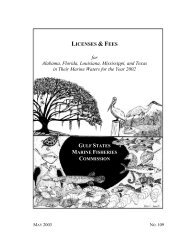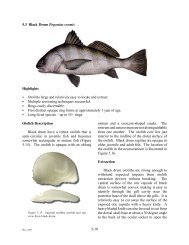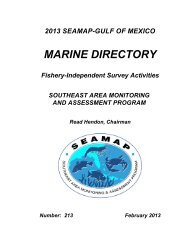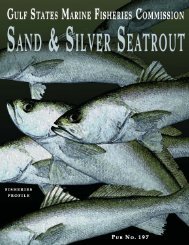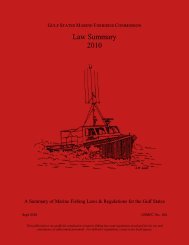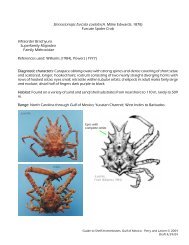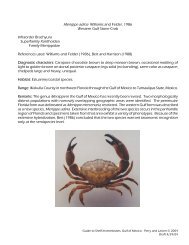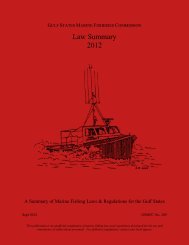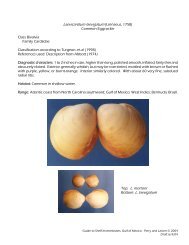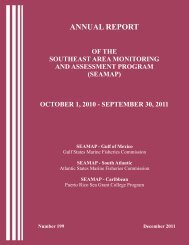Guidelines for Marine Artificial Reef Materials, Second Edition
Guidelines for Marine Artificial Reef Materials, Second Edition
Guidelines for Marine Artificial Reef Materials, Second Edition
You also want an ePaper? Increase the reach of your titles
YUMPU automatically turns print PDFs into web optimized ePapers that Google loves.
competitive attraction to offshore fishermen.” Alabama Liberty ships are easy to locate and readily<br />
accessible, but receive such heavy fishing pressure that size of fish and level of landings are reduced<br />
(Skip Lazauski, personal communication). In Broward County, Florida, despite the fact that fully<br />
half of the 71 reef sites are sunken vessels, nearly all within two miles of shore, recreational hook<br />
and line and spear fishing pressure <strong>for</strong> demersal species has been so intense on the narrow band of<br />
continental shelf (with over 42,000 locally registered boaters) that the local commercial finfish<br />
fishery has seriously declined along with recreational bottom fishing. In that area, vessel reefs<br />
provide the greatest social and economic return through the diving industry (Ken Banks, personal<br />
communication). Milon (1988) reported that anglers prefer sites with higher than average yields and<br />
greater variation in yield. All things being equal, anglers exhibit a preference <strong>for</strong> fishing on natural<br />
habitat. Easily accessible, large wreck sites often do not fit the bill <strong>for</strong> greater variation in yield and<br />
higher yield because they tend to be over-exploited both by hook-and-line fishermen and spear<br />
fishermen using SCUBA. Shipwrecks, like some other artificial reefs, redistribute exploitable<br />
biomass of recreationally and commercially preferred species. Although concentrations may exceed<br />
levels at natural sites in surrounding areas, a more rapid reduction in the amount of exploitable<br />
biomass occurs if fishing is not restricted (Polovina 1991).<br />
Some Atlantic Coast deepwater wrecks (300 to 800 feet) south of Cape Hatteras have <strong>for</strong> years held<br />
populations of slow growing, long lived (25 to 50 years), deepwater groupers, until these sites were<br />
located and intensively fished in the early 1980s (Epperly and Dodrill 1995). In another example,<br />
a single commercial vessel, fishing over a short period of time, harvested four to six thousand<br />
pounds of snowy grouper a week from an 800 foot deep wreck off Fort Pierce of southeast Florida<br />
(Grant Gilmore, personal communication). A single wreck south of Cape Hatteras, North Carolina<br />
in 600 feet of water was reputed to have produced $100,000 in deepwater grouper landings over a<br />
two year period in the early 1980s (Jon Dodrill, personal communication). A previously unexploited<br />
shipwreck off Australia resulted in the harvest of over a ton of snapper species per day, once it was<br />
discovered, until the government stepped in and designated it a sanctuary and historic site (Branden<br />
et al. 1994).<br />
Despite the popularity of some vessel types such as barges, which are readily available through<br />
salvagers and marine construction companies, the lack of structural complexity of these vessels may<br />
render them of lesser value to recreationally and commercially important demersal fish species, as<br />
well as other reef obligate marine life (Ecklund 1994). On deck barges, snapper and grouper appear<br />
to have limited shelter opportunities which chiefly occur in scour depression holes along the base<br />
of the barge, under raked bow overhangs, and in areas of the hull where there are multiple openings<br />
close together, instead of a single entry point (Jon Dodrill, personal communication). Chandler<br />
(1983), in a 1979-80 study of two identical barges sunk at the same time in 1964 in 65 feet of water<br />
and 220 yards apart off Panama City, Florida, showed that the barge having the greater degree of<br />
surface area complexity (due to more rapid deterioration of the deck and opening up of the barge<br />
interior) had a higher fish species diversity and richness. Barges loaded with material which may<br />
increase complexity can create greater fish habitat possibilities and result in holding greater fish<br />
populations than the empty barge itself. Combining increased complexity with, appropriate<br />
placement and a reduction or elimination of fishing pressure can result in site holding dense<br />
concentrations of fish. In January of 1986 during a cold front, a barge carrying 7000 tons of crushed<br />
granite enroute from Savannah, GA to Nassau, Bahamas sank in heavy weather in 80 feet of water<br />
in off Cape Canaveral. When the Space Shuttle Challenger blew up over the Atlantic shortly after<br />
-31-



